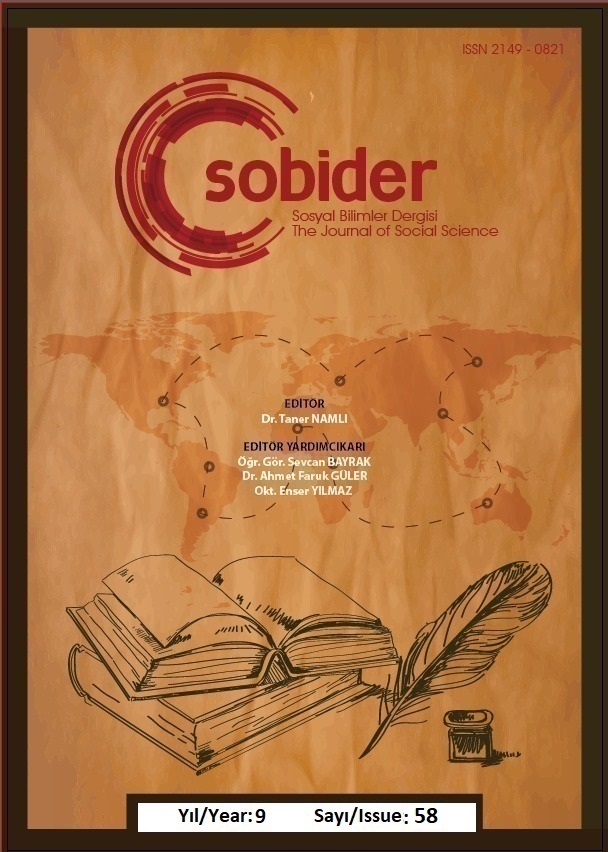Author :
Abstract
Ekspresyonizm, 20. yüzyılın başlarında empresyonizme bir tepki olarak ortaya çıkmıştır. Doğayı olduğu gibi tasvir etmek yerine, sanatçının iç dünyasını, duygu ve düşüncelerini dış dünyaya aktarmayı hedefleyen ekspresyonizm, sanatın tüm dallarında varlık göstermiştir. Almanya’da başlayıp hızla yayılan bu sanat ve fikir akımında sanatçılar, hiçbir kısıtlamaya gerek duymadan kendi iç dünyalarını tüm gerçekliği ile ifade etmeye çalışmışlardır.
Ekspresyonizm akımının Almanya’da ortaya çıkışında; siyasal, ekonomik ve kültürel koşullar, savaşın yıkıcı etkisi ve büyüyen kentler içinde yalnızlaşma etkili olmuştur. Savaşın beraberinde gelen karmaşa, yıkım ve yoksulluk; bireyi burjuvaya karşı bir başkaldırıya itmiştir. Sanatçıların savaş ortamındaki üretimlerine yansıyan isyan ruhu, hissettikleri duyguların yansıması olmuştur. Savaş ortamında sanat, bir propaganda aracı, öfke gösterisi ve çoğu zaman bir eleştiri niteliği taşımıştır. George Grosz, Max Beckmann, Percy Wyndham Lewis ve Otto Dix gibi Alman ekspresyonist sanatçılar, duygusal tepkilerini genellikle, sert fırça darbeleri, konturlar, zıt ve saf renkler ve formda oluşturdukları deformasyonlarla eserlerine yansıtmışlardır.
Bu çalışmada; savaş deneyimlerini, ifadeci anlatımla birleştirerek güçlü bir sanatsal yorum ortaya koyan ve sanatsal üslubunun oluşmasında savaş deneyimlerinin büyük etkisi olan Alman ekspresyonist sanatçı Otto Dix’in hayatı ve sanatı ele alınmaktadır.
Keywords
Abstract
Expressionism emerged in the early 20th century as a reaction to Impressionism. Expressionism, which aims to convey the artist's inner world, feelings and thoughts to the outside world, instead of depicting nature as it is, has existed in all branches of art. In this art and idea movement that started in Germany and spread rapidly, artists tried to express their inner worlds with all their reality without any restrictions.
In the emergence of the expressionism movement in Germany; political, economic and cultural conditions, the devastating effect of the war and isolation in growing cities were effective. The confusion, destruction and poverty that comes with war; pushed the individual into a revolt against the bourgeoisie. The spirit of rebellion, which was reflected in the productions of the artists in the war environment, became the reflection of the emotions they felt. In the war environment, art has been a propaganda tool, a show of anger and often a criticism. German expressionist artists such as George Grosz, Max Beckmann, Percy Wyndham Lewis and Otto Dix generally reflected their emotional reactions to their works with hard brushstrokes, contours, contrasting and pure colors and deformations in form.
In this study; The life and art of the German expressionist artist Otto Dix, who combines his war experiences with expressive expression, reveals a strong artistic interpretation and whose war experiences have a great influence on the formation of his artistic style.
Keywords
- ALTUN, S. U. (2010), “Hitler Almanyası'nda Sanat ve Propaganda”, Sanat ve Tasarım Dergisi, 1 (5), 23-39.
- BEYKAL, C. (2005), “Otto Dix. Eleştirel Grafik” 1920-1924/ Özgün Baskı “Savaş” 1924. İstanbul: Yapı Kredi Yayınları-2246.
- BIRO, M. (2014). “Otto Dix: War and Representation”, Getty Research Institute, 2014, 108- 117.
- EROĞLU, Özkan. (2018), Ekspresyonizm, İstanbul: Tekhne Yayınları.
- KESKİN, İ. (2016), “Baskı Resimde Alman Ekspresyonizmi (Dışavurumculuk) ve Litografi Sanatına Yansımaları”, Sanat Dergisi, Sayı: 25.
- ÖZBAY, D. (2017). “Otto Dix’in “Savaş” Adlı Poliptiği İle Mehmet Ruhi Arel’in “Çanakkale Savaşı” Adlı Triptiğinin Karşılaştırılması Ve Analizleri”, Humanıtas - Uluslararası Sosyal Bilimler Dergisi, 5 (9), 107-119.
- TAŞKESEN, S. (2018), “Ekspresyonizm Akımının Köprü Ve Mavi Atlı Gruplarına Yansımalarının Beden Olgusu Üzerinden Sorgulanması”, Sanat Dergisi, (31), 6-18.
- USTAOĞLU, Canan (2008). “Otto Dix: Şiddet ve Başkaldırı”, Artist Modern Dergisi, Yıl 5, Sayı 89, Mayıs 2008, 52-57.
- WOLF, Norbert. (2005). Dışavurumculuk (Ekspresyonizm). İstanbul: Remzi Kitabevi.
- ZENCİRCİ, D. E. (2012), “Otto Dix ve “Der Krieg” Gravür Serisi”, Atatürk Üniversitesi Güzel Sanatlar Fakültesi Dergisi, Sayı:22.





